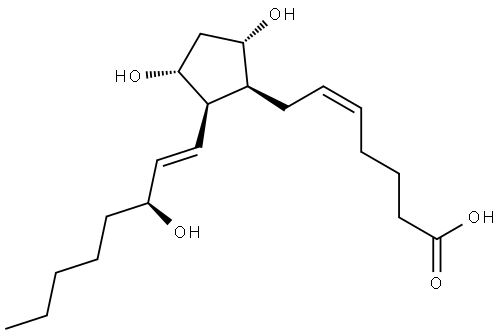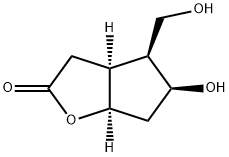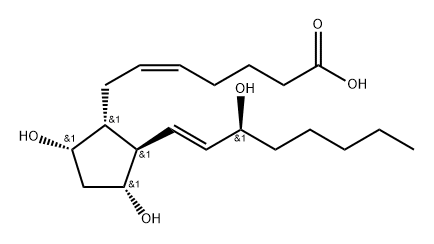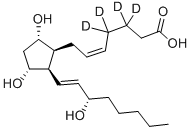11BETA-PROSTAGLANDIN E1
- CAS NO.:27415-26-5
- Empirical Formula: C20H34O5
- Molecular Weight: 354.48
- MDL number: MFCD00084822
- SAFETY DATA SHEET (SDS)
- Update Date: 2024-07-02 08:55:17

What is 11BETA-PROSTAGLANDIN E1?
Description
8-iso PGF2α is an isoprostane produced by the non-enzymatic peroxidation of arachidonic acid in membrane phospholipids. It is present in human plasma in two distinct forms - esterified in phospholipids and as the free acid. The ratio of these two forms is approximately 2:1, with a total plasma 8-iso PGF2α level of about 150 pg/ml in normal volunteers. In normal human urine, 8-iso PGF2α levels are about 180-200 pg/mg of creatinine. 8-iso PGF2α is a weak TP receptor agonist in vascular smooth muscle. Conversely, 8-iso PGF2α inhibits platelet aggregation induced by U-
Description
8-iso Prostaglandin F2α (8-iso PGF2α) is an isoprostane produced by the non-enzymatic peroxidation of arachidonic acid in membrane phospholipids. It is present in human plasma in two distinct forms - esterified in phospholipids and as the free acid. The ratio of these two forms is approximately 2:1, with a total plasma 8-iso PGF2α level of about 150 pg/ml in normal volunteers. In normal human urine, 8-iso PGF2α levels are about 180-200 pg/mg of creatinine. 8-iso PGF2α is a weak TP receptor agonist in vascular smooth muscle. Conversely, 8-iso PGF2α inhibits platelet aggregation induced by U-
8-iso Prostaglandin F2α MaxSpec® standard is a quantitative grade standard of 8-
The Uses of 11BETA-PROSTAGLANDIN E1
(8-epi-prostaglandin F2a) A major metabolite of PGF2α. A prostaglandin derivative used as a biomarker in the diagnosis and treatment of cardiovascular-related diseases as well as biomarkers of total body oxidative stress.
The Uses of 11BETA-PROSTAGLANDIN E1
A major metabolite of PGF2α. A prostaglandin derivative used as a biomarker in the diagnosis and treatment of cardiovascular-related diseases as well as biomarkers of total body oxidative stress.
What are the applications of Application
8-epi-Prostaglandin F2α is a potent vasoconstricting prostaglandin shown to agonize thromboxane receptors
Definition
ChEBI: A prostanoid that is prostaglandin F2alpha having inverted stereochemistry at the 8-position.
Properties of 11BETA-PROSTAGLANDIN E1
| Boiling point: | 531.0±50.0 °C(Predicted) |
| Density | 1.153±0.06 g/cm3(Predicted) |
| storage temp. | Store at -20°C |
| solubility | DMF: >100 mg/ml; DMSO: >100 mg/ml; Ethanol: >100 mg/ml; PBS pH 7.2: 3 mg/ml |
| form | A crystalline solid |
| pka | 4.76±0.10(Predicted) |
| color | White to off-white |
Safety information for 11BETA-PROSTAGLANDIN E1
Computed Descriptors for 11BETA-PROSTAGLANDIN E1
New Products
4-Fluorophenylacetic acid 4-Methylphenylacetic acid N-Boc-D-alaninol N-BOC-D/L-ALANINOL Tert-butyl bis(2-chloroethyl)carbamate 3-Morpholino-1-(4-nitrophenyl)-5,6-dihydropyridin- 2(1H)-one Furan-2,5-Dicarboxylic Acid Tropic acid S-2-CHLORO PROPIONIC ACID ETHYL ISOCYANOACETATE 2-Bromo-1,3-Bis(Dimethylamino)Trimethinium Hexafluorophosphate (6-METHYL-[1,3]DITHIOLO[4,5-b]QUINOXALIN-2-ONE INDAZOLE-3-CARBOXYLIC ACID 4-IODO BENZOIC ACID (2-Hydroxyphenyl)acetonitrile 4-Bromopyrazole 5,6-Dimethoxyindanone 2-(Cyanocyclohexyl)acetic acid 4-methoxy-3,5-dinitropyridine 2-aminopropyl benzoate hydrochloride 1-(4-(aminomethyl)benzyl)urea hydrochloride diethyl 2-(2-((tertbutoxycarbonyl)amino) ethyl)malonate tert-butyl 4- (ureidomethyl)benzylcarbamate Ethyl-2-chloro((4-methoxyphenyl)hydrazono)acetateRelated products of tetrahydrofuran




![[3H]-8-ISOPROSTANE](https://img.chemicalbook.in/StructureFile/ChemBookStructure4/GIF/CB8665179.gif)



You may like
-
 2033-24-1 98%View Details
2033-24-1 98%View Details
2033-24-1 -
 42831-50-5 5-METHYLISOXAZOLE-4-CARBOXYLIC ACID 98%View Details
42831-50-5 5-METHYLISOXAZOLE-4-CARBOXYLIC ACID 98%View Details
42831-50-5 -
 1975-50-4 98%View Details
1975-50-4 98%View Details
1975-50-4 -
 2-HYDROXY BENZYL ALCOHOL 98%View Details
2-HYDROXY BENZYL ALCOHOL 98%View Details
90-01-7 -
 2-Chloro-1,3-Bis(Dimethylamino)Trimethinium Hexafluorophosphate 221615-75-4 98%View Details
2-Chloro-1,3-Bis(Dimethylamino)Trimethinium Hexafluorophosphate 221615-75-4 98%View Details
221615-75-4 -
 61397-56-6 CIS BROMO BENZOATE 98%View Details
61397-56-6 CIS BROMO BENZOATE 98%View Details
61397-56-6 -
 14714-50-2 (2-Hydroxyphenyl)acetonitrile 98+View Details
14714-50-2 (2-Hydroxyphenyl)acetonitrile 98+View Details
14714-50-2 -
 118753-70-1 98+View Details
118753-70-1 98+View Details
118753-70-1